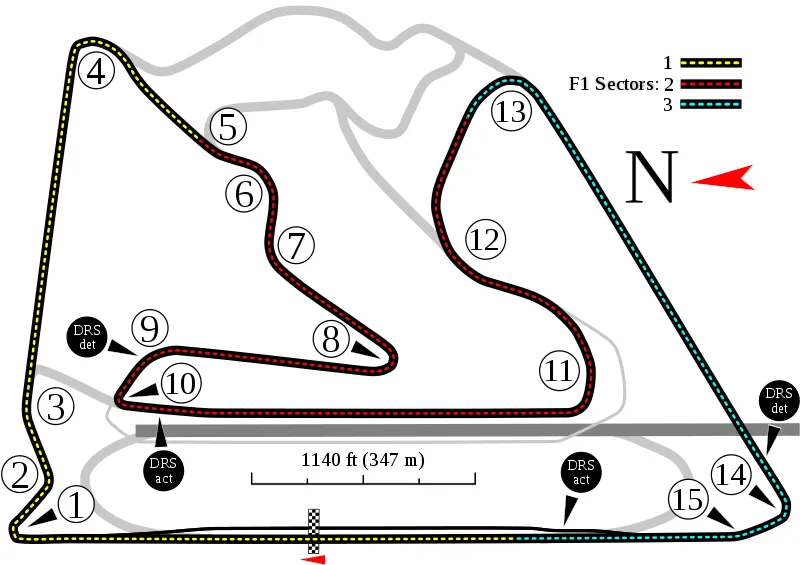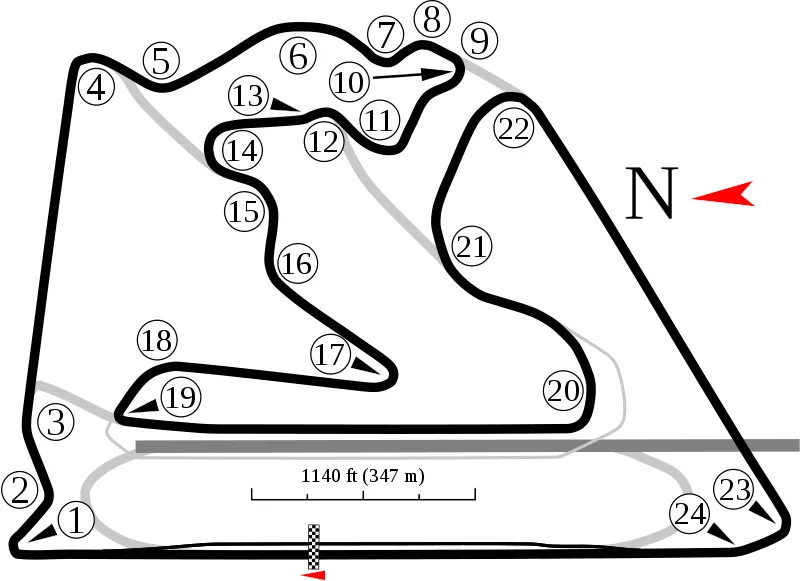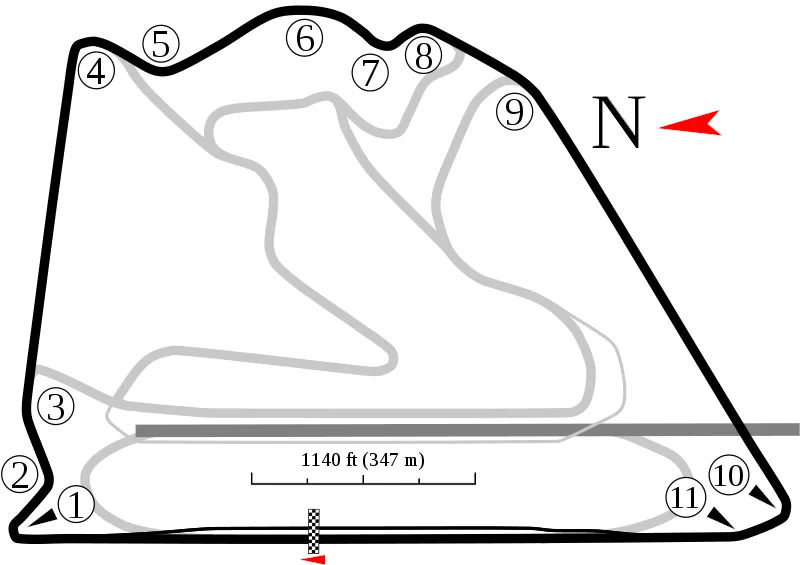Sakhir, el primer circuito en albergar una carrera en el medio oriente, es una pista de carreras diseñada por el Ingeniero Civil alemán Hermann Tilke, cuya construcción se terminó en el año 2004, cuando albergó su primer Gran Premio de Fórmula 1. El costo total del circuito fue de aproximadamente 150M de dólares, y esto sin contar los costos de instalar iluminación artificial en todo el trazado para que se puedan albergar carreras nocturnas desde el año 2014.
Sakhir, the first circuit to host a race in the Middle East, is a racetrack designed by German civil engineer Hermann Tilke, whose construction was completed in 2004, when it hosted its first Formula 1 Grand Prix. The total cost of the circuit was approximately 150M dollars, and this does not count the costs of installing artificial lighting throughout the track so that it can host night races from the year 2014.

La construcción de este circuito fue iniciativa del príncipe de Bahrein Salman bin Hamad Al Khalifa, quien es además entusiasta del deporte a motor, y también es presidente de la Federación de Automovilismo de su país. Bahrein es un país relativamente pequeño ubicado cerca de la península arábiga, el primero de esta zona en ser sede de un Gran Premio de Fórmula 1 (antes que los Emiratos Árabes).
The construction of this circuit was an initiative of the Prince of Bahrain Salman bin Hamad Al Khalifa, who is also an enthusiast of motor sports, and is also the president of the Automobile Federation of his country. Bahrain is a relatively small country located near the Arabian Peninsula, the first in this area to host a Formula 1 Grand Prix (before the Arab Emirates).

Es uno de mis circuitos favoritos, he corrido en el en los juegos de PlayStation. Es una de las mejores obras de Hermann Tilke, el diseñador de circuitos de carreras por excelencia de la Fórmula 1 en la época contemporánea. Bahrein fue su tercer circuito nuevo, luego del circuito de Sepang (Malasia) y Sachsenring (Alemania). Tiene curvas únicas, realmente en términos generales es difícil encontrar alguna curva que ya se haya visto antes en otro circuito. Aunque hay que mencionar que tiene cierto parecido en forma con el circuito de Austria, al cual Tilke había hecho remodelaciones años antes.
It is one of my favorite circuits, I have run on it in PlayStation games. It is one of the best works of Hermann Tilke, the designer of Formula 1 racing circuits par excellence in contemporary times. Bahrain was his third new circuit, after Sepang (Malaysia) and Sachsenring (Germany). It has unique curves, really in general terms it is difficult to find any curve that has been seen before in another circuit. Although it should be mentioned that it has a certain similarity in shape with the circuit of Austria, to which Tilke had made renovations years before.

Uno de los problemas obvios que iban a aparecer en este circuito, es la arena que sería llevada por el viento hasta la pista y a los propios autos, causando posibles problemas de funcionamiento en estos. Esto fue resuelto colocando una especie de pegamento rociado en la superficie de las montañas de arena que circundan al circuito. Sin embargo, restringir totalmente la entrada de arena al circuito es difícil, por ello se han visto en carreras pasadas imágenes como la siguiente.
One of the obvious problems that were going to appear in this circuit, is the sand that would be carried by the wind to the track and the cars themselves, causing possible malfunction in these. This was solved by placing a kind of glue sprayed on the surface of the mountains of sand that surround the circuit. However, to totally restrict the entrance of sand to the circuit is difficult, that's why images like the following have been seen in past races.

Trazados utilizados en Fórmula 1 / Tracks used in Formula 1
El circuito posee 6 configuraciones o trazados diferentes, utilizados en diversas categorías. Sin embargo nos enfocaremos en los 3 que han sido utilizados por la Fórmula 1, los 6 en total, pueden observarse en la página de Wikipedia. La temporada 2020 de Fórmula 1 tuvo la particularidad de poseer dos fechas de Bahrein en el calendario, utilizando dos configuraciones del circuito.
The circuit has 6 different configurations or layouts, used in various categories. However we will focus on the 3 that have been used by Formula 1, the 6 in total, can be seen on the Wikipedia page. The 2020 Formula 1 season had the particularity of having two Bahrain dates on the calendar, using two circuit configurations.
Trazado Grand Prix / Grand Prix layout (5,412 Km)

Este es el trazado habitual de los Grandes Premios celebrados en Bahrein desde 2004, cuando se inauguró el circuito. Se ha corrido todos los años en esta configuración del trazado, excepto en 2011, cuando se canceló la carrera debido a las protestas en el país. No ha sufrido modificaciones en su trazado, excepto un realineamiento en la curva 4 que acortó el circuito en 5 metros.
This is the usual route for the Grand Prixs held in Bahrain since 2004, when the circuit was inaugurated. It has been run every year on this layout, except in 2011, when the race was cancelled due to the protests in the country. It has not suffered any modification in its layout, except for a realignment in turn 4 that shortened the circuit by 5 meters.
Trazado Endurance / Endurance Layout (6,299 Km)
Esta es la configuración más larga del circuito de Bahrein. Fué utilizada en la temporada 2010 de Fórmula 1, por motivo de la celebración del "Jubileo de Diamante", lo cual es una tradición que se celebra al cumplirse el 60° aniversario de determinado evento. La Fórmula 1 llegó a la temporada número 60° en dicho año.
This is the longest configuration of the Bahrain circuit. It was used in the 2010 Formula 1 season, to celebrate the "Diamond Jubilee", which is a tradition celebrated on the 60th anniversary of a certain event. Formula 1 reached the 60th season in that year.

La diferencia con el circuito usual radica en la adición de un nuevo sector a partir de la curva 4, el cual consta de una serie de curvas de media-baja velocidad y muy cortas rectas. El circuito pasa de 15 a 24 curvas. Esta nueva zona de curvas lentas añade cierta dificultad a los adelantamientos, a excepción de la curva 6 que se toma a fondo y suele brindar oportunidad de rebasar otro auto al llegar a la curva 7.
The difference with the usual circuit lies in the addition of a new sector from turn 4, which consists of a series of medium-low speed and very short straight curves. The circuit goes from 15 to 24 curves. This new area of slow curves adds some difficulty to overtaking, except for turn 6 which is taken in full and usually provides an opportunity to pass another car when reaching turn 7.
Trazado exterior (perimetral) / External layout (perimeter) (3,543 Km)

Esta configuración se ha corrido únicamente en la temporada 2020 de Fórmula 1, en la que se corrió un Gran Premio en el trazado usual y otro en este. Al evitar transcurrir por la zona interna del circuito, se eliminan ciertos sectores de media-baja velocidad, resultando en un trazado donde predomina la alta velocidad por sus largas rectas y pocas curvas. Es un circuito donde se vieron frecuentes adelantamientos durante la carrera de 2020.
This configuration has only been run in the 2020 season of Formula 1, where one Grand Prix was run on the usual track and another on this one. By avoiding the internal zone of the circuit, certain sectors of medium-low speed are eliminated, resulting in a track where high speed predominates due to its long straights and few curves. It is a circuit where frequent overtaking was seen during the 2020 race.
Análisis del circuito / Circuit analysis
Ya en anteriores entregas, he realizado ciertos análisis de los circuitos donde se han celebrado las carreras de este año 2020, específicamente desde el Gran Premio de Eifel en el circuito de Nürburgring. Particularmente en una publicación, escribí sobre lo que hacía únicos a los circuitos de leyenda. Los circuito de leyenda son aquellos circuitos míticos del siglo pasado, que poseen ciertas características. En este sentido, Bahrein entra más bien en el grupo de los circuitos modernos, que llevan poco tiempo dentro del calendario, y tiene características diferentes a los circuitos clásicos.
In previous issues, I have made some analysis of the circuits where the races have been held this year 2020, specifically since the Eifel Grand Prix at the Nürburgring circuit. Particularly in a publication, I wrote about what made the legendary circuits unique. Legend circuits are those mythical circuits from the last century, which possess certain characteristics. In this sense, Bahrain is more in the group of modern circuits, which have been around for a short time, and have different characteristics from classical circuits.

Nos referiremos al trazado Gran Prix (configuración normal de 5,412 Km). El circuito de Bahrein es relativamente plano, aunque posee cierta elevación de la curva 11 a la 13 y vuelve a bajar durante la recta entre las curvas 13 y 14. No es tan estrecho como los circuitos clásicos, y se caracteriza por poseer una zona muy técnica de media-baja velocidad (de curva 5 a curva 10) y frenadas fuertes luego de largas rectas (curvas 1, 4 y 14). A pesar de ser un poco trabado en algunos sectores, no ha dejado de brindar carreras muy entretenidas en el pasado, y luchas importantes como la de Hamilton-Rosberg en 2014.
We will refer to the Grand Prix layout (normal configuration of 5,412 Km). The Bahrain circuit is relatively flat, although it has a certain elevation from turn 11 to turn 13 and it goes back down during the straight between turns 13 and 14. It is not as narrow as the classic circuits, and it is characterized by having a very technical zone of medium-low speed (from turn 5 to turn 10) and strong braking after long straights (turns 1, 4 and 14). Despite being a little stuck in some sectors, it has not stopped providing very entertaining races in the past, and important fights like the Hamilton-Rosberg in 2014.

Una de mis zonas favoritas es la sucesión de curvas de media-alta velocidad desde la curva 11 a la 13. Esta zona tiene un cierto parecido con algunos circuitos clásicos, en donde hay curvas redondeadas de radio grande. Podría pensarse en la curva 11 como una versión un poco más pequeña de la curva Pouhon de Spa-Francorchamps. Otra curva muy especial y característica de este circuito es la primera (imagen de abajo). Es, en mi opinión, una de las mejores primeras curvas de todo el calendario. La combinación de una curva lenta y muy pronunciada con otra curva más leve casi inmediatamente después siempre da largadas y luchas por posiciones que dan espectáculo.
One of my favorite zones is the succession of medium-high speed curves from turn 11 to turn 13. This zone has a certain similarity with some classic circuits, where there are big radius rounded corners. You could think of turn 11 as a slightly smaller version of the Pouhon curve of Spa-Francorchamps. Another very special and characteristic curve of this circuit is the first one (image below). It is, in my opinion, one of the best first corners of the whole calendar. The combination of a slow and very pronounced curve with another lighter curve almost immediately after always gives starts and fights for positions that give spectacle.

La curva 4 es otra curva muy interesante, el asfalto en el borde izquierdo de esta curva se extiende un poco más allá, y además brinda espacio para diferentes trayectorias de los vehículos. Se suelen ver adelantamientos espectaculares en esta curva, sobre todo en las otras dos configuraciones del circuito, donde otra curva inmediatamente a la izquierda brinda otras posibilidades de rebase.
Turn 4 is another very interesting curve, the asphalt on the left edge of this curve extends a little further, and also provides space for different vehicle trajectories. Spectacular overtaking is usually seen in this curve, especially in the other two configurations of the circuit, where another curve immediately to the left provides other possibilities of overtaking.
Translated to English with the help of DeepL.com.
| ¡Gracias por visitar!.. Deja tu comentario 🚥🏆  |
